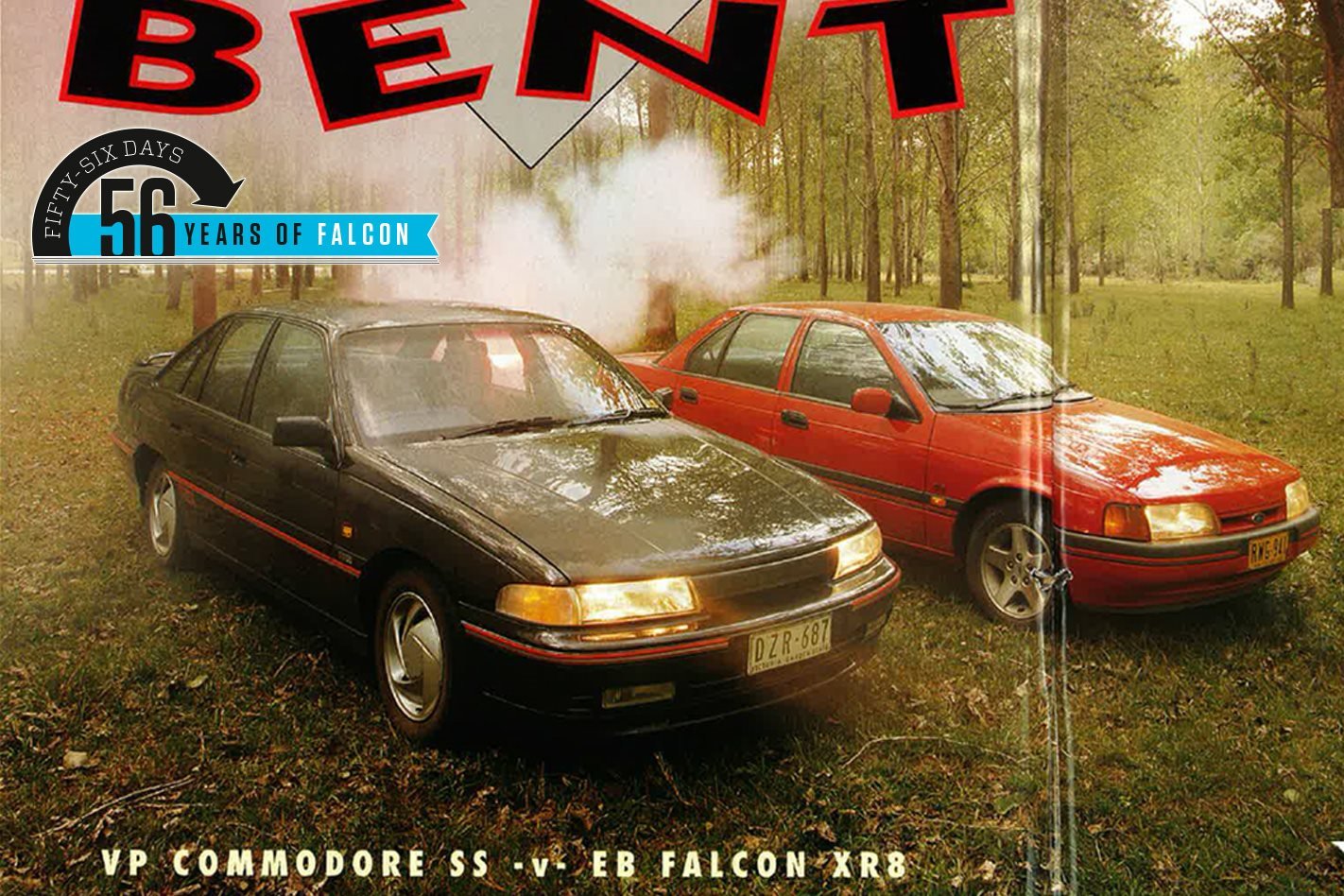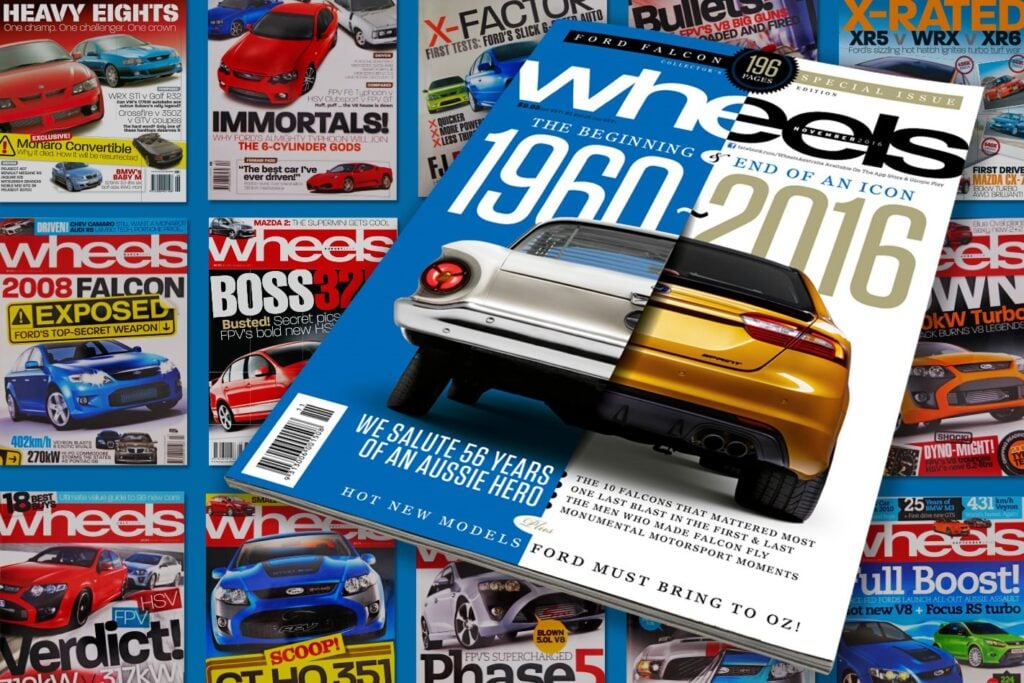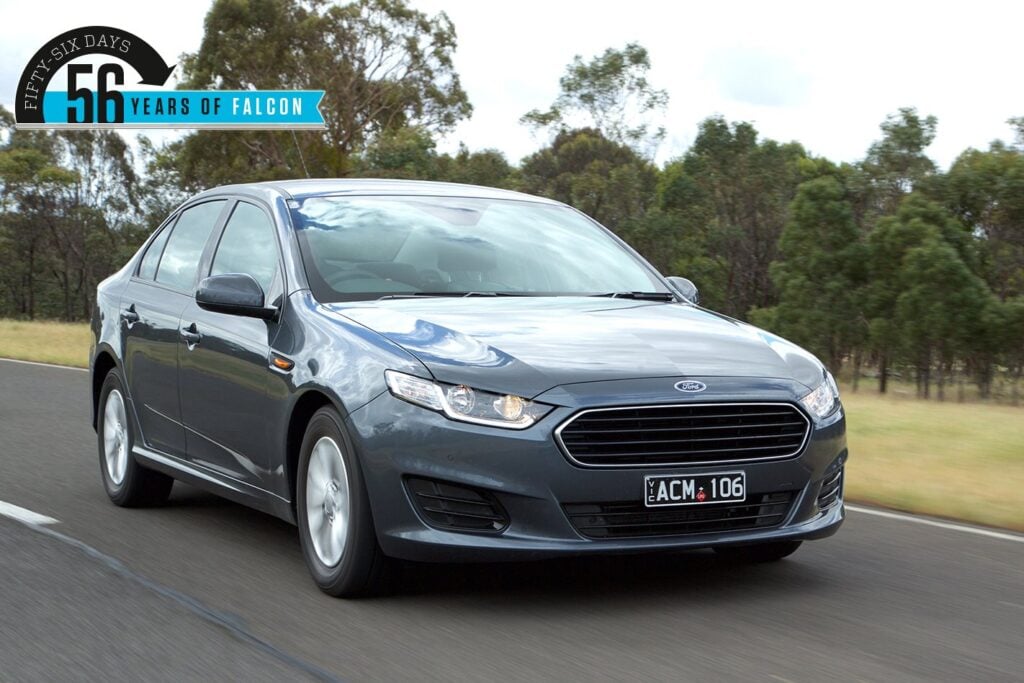First published in the May 1992 issue of Wheels magazine, Australia’s best car mag since 1953.
After the Falcon XR8 nudged out the VN SS in August this year, the VP now carries Holden’s hopes in the bent eight battle. And this time, as KEVIN BARTLETT and MICHAEL STAHL report, there’s a twist in the tail.
Somebody or other is quoted on Ford’s TV commercial for the Ford Falcon XR8: “And the bad news? There is no bad news.”
Sorry, son, but now there is. And it’s plenty bad for the Falcon V8 that has held a brief and slender reign over its arch rival Holden VN Commodore SS V8. The news is that the incoming VP Commodore SS not only got a facelift, but a big nip and tuck in the tail as well.
The inclusion of independent rear suspension, along with detail changes in the front end and a veritable Christmas stocking’s stuffing of standard equipment, appears to have swung the Aussie V8 balance back in Holden’s favour.
The stated aim with the Ford EB Falcon and VP ranges was to refine the existing product rather than radically revamp. For both camps it was a choice dictated by economies anyway, but the advances in overall quality and equipment value for money are palpable in both cars. Ford, pitching its first V8 in almost a decade, must have gnawed a few nails before Holden showed its ace in early October.
They may be gnawing yet. IRS – still exclusive to Holden – is optional on lower six -pack models, but comes standard on the SS. And an SS option Ford can’t match is the availability of an upgraded, 180 kW engine, courtesy of Holden Special Vehicles.
While the option price has yet to be fixed, the 180 kW package is almost threatening to HSV’s own model range, given the stock SS now has the rear end skill to get that through to the road. Both manual and auto SS Holden Commodores get a limited-slip diff as standard. For the Falcon XR8, however, the four speed auto faces an extra cost option LSD.
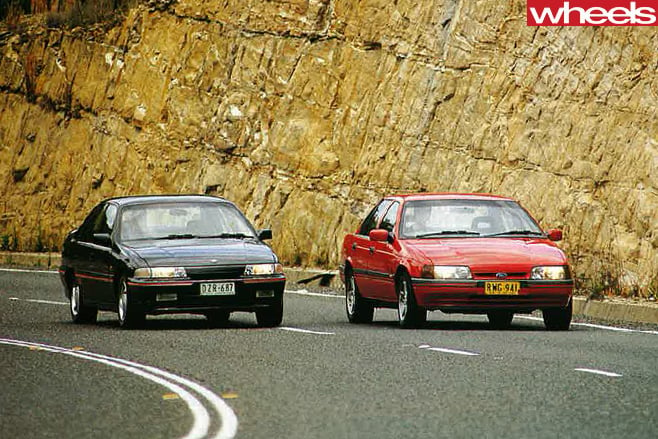
The Commodore SS and Falcon XR8 are the grown up, body haired versions of six cylinder ‘S’ packs, which are in turn essentially striped and sportified Executive fleet models. There’s still a hint of austerity inside both cars, the Ford half of which lists for $33,161 in auto form (manual $32,595), the Holden for $33,092 auto (manual $32,492).
Both V8s retain manual windows and S pack level , cloth trimmed ‘sports’ seats. The Commodore’s cloth trim is much the nicer of the two. From there, both step up with central locking, remote boot and fuel releases, power mirrors and alloy wheels as standard equipment.
The Holden alone boasts an electric antenna and front fog lights. Significantly, however, the air-con that’s standard in the Falcon is a $1778 option in the Holden. Our test duo’s only other option was the Commodore’s $356 cruise control, an ideally suited accessory sadly lacking in the Falcon.
In fact, power windows aren’t available in the Falcon either – you have to buy a Ghia, we suppose. Holden buyers can luxury-up with power windows in the front ($392) or all round ($785).
Mechanically, both are similar in having 5.0 litre, pushrod ohv, fuel injected V8s. Power outputs are identical at 165 kW apiece, but the Ford slightly out-torques the Holden by 3 Nm, and does so lower in its rev range. Holden’s four speed autobox is not electronically controlled like the Ford’s and also lacks the dual mode facility (power/econ), but both have lock-up torque converters. At the rear end, the auto Ford’s LSD option would be worthwhile at $419. We know, because ours didn’t have it.
Inside, the seats in both cars are more generously contoured than the fleet hack items. Both cars have height adjustable drivers’ cushions, the Ford adding a lumbar lever to its backrest.
The Falcon gets a height and reach adjustable steering column too, but with an awful wheel at the end of it. The Holden has a smaller, more grippy four spoke wheel, but the spokes are too long and it’s difficult to avoid tripping the horn with the heels of your hands.
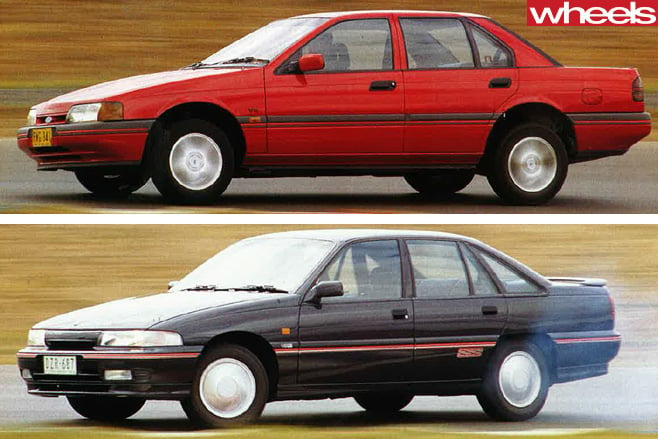
The Ford V8 carries a redline of 5000 rpm and the tacho calibrations end at 6000, but it has no electronic cut-out. The Holden, on the other hand, redlines at 5500 rpm and cuts abruptly at 5800.
None of that tells you anything, though, because the Holden needs to rev, while the Ford packs a noticeably greater punch at the bottom end and feels about the same at the top.
The Falcon is a deceptive performer. While feeling like a heavier and larger car, and lacking the induction bark of the Holden, the Ford is most likely to impress your neighbours with its surge of acceleration in the lower rev range. It’s more useable, if only marginally so.
The Holden feels a little flat until 3300 rpm or so, at which point it sounds and acts with the enthusiasm you’d expect. Helping the Commodore along are a set of transmission shift points that better complement the engine’s top-endy character. Though the Ford’s transmission ratios feel very similar to the Holden’s, it still only shuffles up between the cogs at 4800 rpm in Sport mode. The Commodore will hold its latter two upshifts to 5300 rpm, which feels and works better.
Over standing start acceleration, the two slushbox V8s are virtually identical. The Holden leaps away from the line a little better, the result of its greater rear end grip, but the Ford soon draws level and works out a tad faster to 140 km/h.
Over the standing 400 metres, it’s lineball. The Falcon’s beefier bottom end surge puts it a shade ahead in the overtaking increments. But really, where engines are concerned, there’s a lot of hair on both and barely a hair’s-breadth between them.
Out in the real world, the Holden has the nicer transmission to use manually. Both shift up and down automatically with acceptable smoothness, but the Ford tends to kick down from top to third a little too eagerly with the switch set in Sport mode.
In their respective, official AS2877 fuel consumption figures, Ford claims its auto XR8 to be slightly more frugal than Holden’s auto V8: 14.5 L/1 00 km city, 9.0 highway versus the General’s 15.0 city, 9.5 highway. That’s certainly how it came out for us, too, with the Ford usually one or two litres per 100 km to the better of the Holden. lt goes against expectations – the Ford is the heavier car, after all, and while its torque converter is of the lockup type, it seems to do so less obviously than the Holden’s, which can be felt locking and unlocking while cruising.
But the Ford’s best of 13.5 compares with the Holden’s best of 14.8 L/1 00 km. Offsetting that is the Holden’s standard 80 litre tank, versus the Falcon’s 68 litre unit. With worst figures of 17.6 (Holden) and 17.3 (Ford), their respective ranges work out at 454 km and 393 km.
Before, when the Falcon and the Commodore were both lumbered with a rigid rear axle, the Ford always got the nod for having the better behaved chassis. It started life with a fundamentally better track width to wheelbase relationship; the Ford stands like a cat, the Commodore like a pigeon. Pardon the mixed menagerie of metaphors but, with its IRS Commodore, Holden has neatly leapfrogged the Ford – if only by about the same margin of advantage.
The Commodore’s niceness goes further than just the rear end behaviour, however. Having a tailshaft and diff now fixed firmly in place has dramatically helped isolate drivetrain noise and vibration. And subtle changes elsewhere have enhanced the overall stability and cornering confidence.
Take a look at the MacPherson strut towers on the SS and you’ll see an adaptor plate that relocates the top strut mount rearwards, thus cranking on more positive castor.
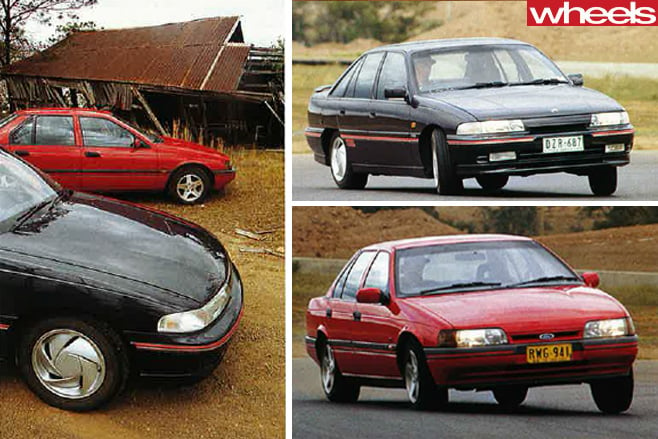
All of which is the reverse of the old Commodore live axle, which lurched into corners like a backhanded slap, then bounced and jiggled and did its best to swap ends all the way through.
The Commodore’s cause has also been helped significantly by the increased track widths that form a part of the IRS package. Front track is up by 34 mm and rear by 9 mm over the live axle models. Even so, compare the SS’s tracks of 1485/1487 mm against the Falcon’s fat 1554/1533, and you’ll see that the slightly longer Ford still has the better footprint on the road.
They both point into corners well, though their steering Is quite different.
Whereas the Commodore’s strong self-centring and on-centre precision is followed by a numbness and lack of feel under cornering load, the Falcon is simply more precise and pointable throughout. It just bites and turns in.
In the Falcon you’re having to think more about the road surface and the corner itself and, although the tail will swoop and dive over undulations, it remains fairly true to its line. Once pointed it will basically stay pointed and won’t launch into anything too alarming, apart from spinning its non-LSD inside rear wheel when you try to keep up with the squatting, squirting Commodore exiting a corner. Overall, Ford has done about the best job possible with this rigid rear axle.
Both cars wear similar sized, 205/65R15 tyres – Dunlop Monza 08s for the Holden, and Pirelli P600s on the Ford. The latter represents a better mating to its chassis, and is more progressive in the wet. Braking is much of a muchness, although the Com modore sometimes feels likely to lock its rears under quick, panic situations.
Otherwise, neither car is unstable under heavy braking. Cornering speeds are also consistently similar – both demand a power-on cornering technique to get their chassis working – but the Falcon driver has to think and work harder for equal progress. Point to point, the Falcon driver needs more concentration and steering and throttle corrections to compensate for his car’s deficit in poise over bumps and grip out of corners.
He’s less comfortable, too, because the Commodore absorbs big bumps better at both ends than the Ford. While the Falcon is initially more compliant over little jiggles in the road, anything more significant will thump up through the chassis and show up a slight inadequacy in damping control.
The whole Falcon experience is also noisier and not In its most pleasant way. lt’s worth noting that our test Falcon had 18,000 km on the clock when we got it and the Commodore only 2500 km, but the Falcon creaked and rattled like a drunken old bastard on unmade roads.
On smoother surfaces, while engine noise is roughly equal, the Falcon cabin has a lot more road and suspension noise coming up through the floor and wind roar from the B pillars. The Holden, meantime, gets some rumble from its Dunlops and some wind noise around the mirrors and A pillars but, in terms of cabin isolation, the Commodore feels as though there’s another $10,000 in it.
That same impression is carried over to the interiors. The Commodore feels like a more highly specced car than the Falcon, with fewer expanses of bare grey plastic and more of the nifties you need.
The changes have been subtle since we tested the manual VN SS against the manual XR8 in our August issue. Apart from the equipment upgrades already mentioned, the front seats are now Calais-sourced items, with plusher trim and padded headrests.
Driving positions are noticeably different, with the Falcon’s cabin feeling low and broad from the driver’s seat and the Commodore more narrow and upright. Bouquets to Ford for its height and reach adjustable steering column: brickbats because the column itself is still offset to the right. The Commodore’s fixed column is nonetheless well positioned, in concert with the height adjustable seat cushion. Its front centre and door armrests are also better placed, and you’ll find door map pockets only in the Holden.
Instrumentation is adequate analogue in both cars, but we’ve never much liked the Commodore’s binnacle mounted wiper switch, or the shape of the single indicator/flash stalk, which encourages your finger to slip off. While the Commodore offers useable grab handles in the doors, the Falcon has less practical overhead grab handles, and only clumsy, nail breaking handles with which to shut the doors.
Also, while the Commodore’s doors have stops, the Falcon’s have none. We found it annoying, as will the owner of the car parked next to you the first time you discover this shortcoming.
Rear benches, meantime, are unchanged from the standard S pack items, and neither car gets rear headrests. A split/folding backrest features in the Falcon, while the Holden has boot access via a large centre port. Both boots carry alloy spare wheels, so no skimping there.
It was only August that we gave the nod to the Falcon XRB manual over the VN Commodore SS. So soon have the roles selected A-for-reverse when we got the automatics together.
But this VP Commodore SS isn’t just an auto-equipped facelift doing battle against its Falcon counterpart. With Holden’s continuing battle of persistence over a fundamental design disadvantage, the VP SS comes together as a nicely integrated touring car. Equipment and overall refinement are helping the SS shrug its humble fleet hack heritage – a feeling that still lingers in most aspects of the Falcon XR8.
The margin isn’t nearly as great as you might expect, given the potential of the Commodore’s IRS, but it is the better value package. For the moment, a case of the news versus the olds.
Check out Wheels Archive online now for other great Ford Falcon features and more from decades past!
Simply log in here using your existing MagShop account or create a FREE account and select this article from the homepage.
Don’t have a MagShop account?

Have a MagShop account?


